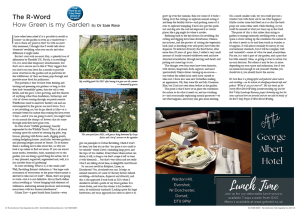How Green is my Garden

I have often been asked if it is possible to rewild at home—in the garden or even in a windowbox—and is there any point in that? So with no-mow May imminent, I thought that I would talk about ‘domestic’ rewilding, what you can do and what difference it might make.
But let’s start with no-mow May, a splendid use of alliteration by Plantlife UK. Firstly, is it rewilding? No, it is more like temporary abandonment, but that’s not a reason not to like it! They suggest that you don’t cut your lawn for a month to provide more structure in the garden and in particular let the wildflowers (if they are there) pop through and provide more food for pollinators.
The problem is that we have been feeding and treating and preening our gardens so long so that they look ‘beautifully’ green, that the soil is very fertile, and the grass is fast growing, and the chances of anything other than dandelions, buttercups and a bit of clover coming through are pretty remote. Wildflowers tend to need low fertility soil and are outcompeted by the grasses on most lawns. So it is not rewilding, no, but do go ahead in May—it is certainly better for nature than cutting the lawn every 5 days—and if you are going to mow, you might want to cut around the clumps of flowers that do come through until they have gone over.
So what about ‘wildlife gardening’, heartily expounded by the Wildlife Trusts? This is all about creating space for nature by creating log piles, bug houses, planting wild-flower seeds, digging ponds, making hedgehog homes (and holes between gardens) and planting hedges instead of fences. To be honest there is nothing not to like about this, so why not look it up online to find out more. If you can attract more moths, butterflies, birds, mammals etc to the garden, you are doing a good thing for nature, but it is very planned, organised, regimented and, well, it is just another form of gardening!
So onto rewilding. What is it, at the small scale? Well, Rewilding Britain’s definition is “the large-scale restoration of ecosystems to the point where nature is allowed to take care of itself”. Hmm, that’s not going to work—but it is not definitive. Mossy Earth define urban rewilding as “about bringing back elements of wilderness, embracing natural processes and restoring ecosystems with less human interference”.
Citizen Zoo—a great bunch from London—even give six principles to Urban Rewilding, which I won’t list here, but they do say that “no space is too small to be valuable” which I love—including lamp posts and the tops of bus shelters. Everywhere where nature can thrive, it will, as long as we don’t scrape it off or treat it with chemicals… but that’s very urban and not really what I am talking about here, in delightful rural Dorset.
So can you rewild in Bridport, Lyme, or Dorchester? Yes, absolutely you can. It helps to remind ourselves of some of the key factors behind rewilding—disturbance, dispersal and diversity, and this is the approach I took back in 2021 when I decided to rewild a patch of my front garden. It is about 6x4m, and over the winters it has looked a mess, by traditional standards! Lacking space for large herbivores, my basic approach has been to allow it to grow up over the summer, then cut some of it back—taking away the cuttings to replicate animals eating it and keep the fertility down—and pushing some of it over to replicate trampling. I have also got the spade out and dug into the soil and exposed it in various places like a pig might do when it rootles.
Referring back to the key factors for rewilding, the cutting and digging have been disturbance, whereas my trousers, and the process of cutting the vegetation back (and so knocking over seed pods) have been the dispersal. To kickstart diversity, the third factor, after more than 20 years of grass lawn, I added a very small amount of locally sourced wildflower seed and have attracted invertebrates through leaving seed heads and putting out some logs to rot.
The changes over four years have been fantastic, with clovers, knapweed, dock, ragwort, and most spectacularly Oxeye daisies turning up en-masse—way before the added local seeds have started to take root. I have also seen new butterflies making an appearance. Ok, they were Mr and Mrs Common Blue, but I had not seen them before in the garden.
The point is that I have set in place the conditions for nature to do what it needs to, and am watching it—and occasionally replicating natural processes—to see what happens; and every year gets more exciting. On a much smaller scale, yes you could put out a window box with fresh soil to see what happens! Maybe scatter some bird feed on it so that the birds poop out some other seeds whilst feeding, or you could be amazed at what just turns up in the wind.
The point of this is that rather than trying to garden or manage intensely, rewilding even a small space is about setting up the conditions for nature to do what it needs to do and then watch in wonder as it happens. It will almost certainly be messy, by our conventional standards, but it will be complex, wild and ‘natureful’—more of what we need, everywhere. For me, it is only a part of my garden, and a part that has little amenity value, so giving it over to nature was an easy decision. For others it may be less or more depending on your space and inclination, but if you are interested enough to ask yourself whether you should do it, you already know the answer.
Dr Sam Rose is a photographer and podcaster about nature and rewilding—see his website at whatifyoujustleaveit.info and podcast “What if you just leave it?”. He also heads up the charity West Dorset Wilding (westdorsetwilding.org) and the Brit Valley Landscape Recovery project (britvalley.org) but the views expressed here are personal and are not said on behalf of the Brit Valley Project or West Dorset Wilding.



